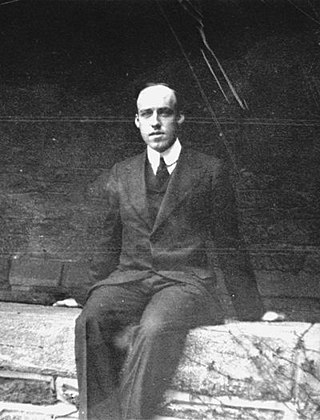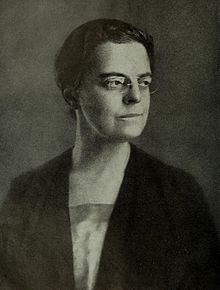
Bryn Mawr College is a private women's liberal arts college in Bryn Mawr,Pennsylvania,United States. Founded as a Quaker institution in 1885,Bryn Mawr is one of the Seven Sister colleges,a group of historically women's colleges in the United States. The college has an enrollment of about 1,350 undergraduate students and 450 graduate students. It was the first women's college to offer graduate education through a PhD.

Martha Carey Thomas was an American educator,suffragist,and linguist. She was the second president of Bryn Mawr College,a women's liberal arts college in Bryn Mawr,Pennsylvania.

Lily Ross Taylor was an American academic and author,who in 1917 became the first female Fellow of the American Academy in Rome.

Rhys Carpenter was an American classical art historian and professor at Bryn Mawr College.
Machteld Johanna Mellink was an archaeologist who studied Near Eastern cultures and history.
Susan Treggiari is an English scholar of ancient Rome,emeritus professor of Stanford University and retired member of the Faculty of Classics at the University of Oxford. Her specialist areas of study are the family and marriage in ancient Rome,Cicero and the late Roman Republic.

Maud Wood Park was an American suffragist and women's rights activist.

Frederica ("Freddy") Annis Lopez de Leo de Laguna was an American ethnologist,anthropologist,and archaeologist influential for her work on Paleoindian and Alaska Native art and archaeology in the American northwest and Alaska.
Eleanor Bontecou was an American lawyer,civil rights advocate,law professor and government official. Bontecou served as an attorney and investigator for both the U.S. Department of Justice and U.S. War Department. She also worked as a professor at two universities. During her career,Bontecou achieved national fame for her work in the civil liberties and women's rights movements.

Millicent Carey McIntosh was an educational administrator and American feminist who led the Brearley School from 1930 to 1947,and Barnard College from 1947 to 1962. The first married woman to head one of the Seven Sisters,she was "considered a national role model for generations of young women who wanted to combine career and family," advocating for working mothers and for child care as a dignified profession.

Eleanor Gladys Copenhaver (1896–1985) was a social worker and activist who spent over 40 years as an organizer and community service worker for the YWCA. She began as a community organizer and worked her way up to the labor division,finally becoming head of the Industrial Division from 1937 to 1947. At the end of World War II,when women were phased out of the labor market,she was briefly dismissed,but then hired back to organize support for the communities springing up around the defense industry.
Stephen Joseph Herben Jr. was an American professor of philology at Bryn Mawr College. He specialized in English and German philology,and among other places did work at the American-Scandinavian Foundation in Copenhagen and Oxford University,as well as at Rutgers,Princeton,and Stanford University. His work included assistance with the etymological work of the second edition of Webster's New International Dictionary,and two articles on medieval literary descriptions of weapons and armor. The second of these articles,"Arms and Armour in Chaucer",is still considered a standard on the subject.

Eleanor Axson Sayre was an American curator,art historian,and a specialist on the works of Goya. She was the first woman to serve as departmental curator at the Museum of Fine Arts,Boston. Working as curator of prints and drawings,she collected Goya's etchings from museums around the world to catalogue and create international exhibits. She was awarded a knighthood with the Lazo de Dama in the Order of Isabella the Catholic by Spain in 1975 and the Gold Medal of Merit in the Fine Arts in 1991.

Susan Myra Kingsbury was an American professor of economics and a pioneer of social research. Kingsbury helped to establish the American Association of Schools of Social Work,and served as vice president of the American Sociological Society and American Economic Association. During her time at Bryn Mawr College,Kingsbury established courses and opportunities for women in the industrial workforce.

Emily Wilmer Cave Wright was a British-born American classical philologist,and a contributor to the culture and history of medicine. She was a professor at Bryn Mawr College,where she taught Greek. Wright's works include,The Emperor Julian’s relation to the new sophistic and neo-Platonism (1896),A Short History of Greek Literature,from Homer to Julian (1907),Julian (1913–23),Philostratus and Eunapius:The Lives of the Sophists (1922),Against the Galilaeans (1923),Hieronymi Fracastorii de contagione et contagiosis morbis et eorum curatione libri III (1930),and De morbis artificum Bernardini Ramazini diatriba (1940). Giovanni Maria Lancisi:De aneurysmatibus,opus posthumum (1952),and Bernardino Ramazzini:De Morbis Typographorum (1989) were published postmortem.

Agnes Low Rogers was a Scottish educator and educational psychologist.
Edith Fishtine Helman was an American scholar of the Spanish Enlightenment and professor at Simmons College.
Lois Scharf is an American historian and writer specialized in women's history,family organization,and feminism. She served as the executive director of the National History Day program from 1978 to 1992. Scharf has taught at John Carroll University and Case Western Reserve University.

Isabel Cooper Mahaffie was an American artist known for her work depicting animals. She was a staff artist for the New York Zoological Association who participated in multiple research expeditions,such as the Arcturus expedition.
Helen Hill Miller was a journalist and author of more than 20 books,but may be best known for her politician spouse and son. She would have become the First Lady of Virginia when her husband Francis Pickens Miller ran (unsuccessfully) in the Democratic primary in 1949 against the Byrd Organization candidate John S. Battle. In 1977,before his father's death,their son Andrew P. Miller,who served two terms as Attorney General of Virginia also lost in the Democratic gubernatorial primary.













